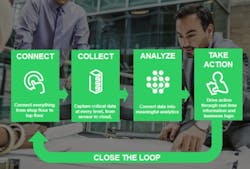Though Schneider Electric has had its EcoStruxure architecture for a few years now, its latest launch takes advantage of the latest Internet of Things (IoT) capabilities to provide a more open, scalable and interoperable platform that caters to a more electric, more digitized, more decarbonized and more decentralized world. Rather than a generic, horizontal platform, EcoStruxure incorporates years of experience for very domain-specific connectivity for data centers, buildings, grid and industry to deliver enhanced value around safety, reliability, efficiency, sustainability and connectivity.
In addition to the latest platform launch, Schneider Electric announced a new partner community—with technology and consortium partners, including flagship partners Microsoft and Intel.
EcoStruxure is a three-level technology stack, including embedded connectivity and intelligence, local analytics at the edge, and cloud-based services. “The way it comes all together is how we maximize our value of data,” said Prith Banerjee, executive vice president and chief technology officer for Schneider Electric. He talked about the platform’s ability to collect the data, do some analysis at the edge, and have more massive compute capabilities in the cloud.
The technology stack is built first on Schneider Electric’s core competency in connected products such as sensors, medium- and low-voltage breakers, drives and actuators. An edge control layer gives organizations the ability to manage their operations on-premise as well as from the cloud. This includes connected control platforms with remote access, advanced automation and operator override capabilities. Hardware-agnostic software, analytics and services make up the third layer of the stack.
“In this EcoStruxure platform, it’s not just about connectivity,” Banerjee said. “It’s about taking action, closing the loop.”
Much of this has to do with leveraging the strength of the ecosystem partners, Banerjee noted. Microsoft, for example, provides the Azure cloud platform to deliver digital services, apps and analytics from Schneider Electric and third parties. Azure eases technology development on the platform and enables Schneider Electric to rapidly scale public, private and hybrid cloud solutions.
Banerjee also noted the “strong partnership with Intel” and its device intelligence platform. Schneider Electric leverages Intel’s field-programmable gate arrays (FPGAs) to enhance the performance, power and flexibility of the EcoStruxure architecture to enable smarter operations. This technology comes in large part from Intel’s acquisition of FPGA provider Altera, completed late last year, including ARM-based capabilities.
Other key partnerships involve IT companies like Accenture, ARM and Cisco, Banerjee said, which will be instrumental in enabling the IT/OT convergence that IoT solutions demand. New partnerships continue to emerge with specialized technology providers like Zuora, which has a cloud-based subscription management platform; and global players like Panasonic, which Schneider Electric recently partnered with to simplify energy management for building customers.
A key value that Schneider Electric provides to the partnerships and the EcoStruxure platform, Banerjee said, is its strong presence in four end user markets—buildings, industry, grid and data centers. He also noted four general values that EcoStruxure provides: maximized energy efficiency and sustainability; optimized asset availability; smart, productive, profitable operations; and mobile insight and proactive risk mitigation.
For the utilities market specifically, EcoStruxure provides grid efficiency for high-performance real-time operations, Banerjee said. “The new world out there is a world of distributed energy,” he said, referencing the change that renewable energies have brought to grid management. “The smart grid requires a lot more sophistication.”
Examples of work being done with customers include a 4 percent reduction in energy losses for Italian electricity distributor Enel; an outage management system for Philippine electric company Meralco that reduced interruption indicators by 22 percent; and grid efficiency improvement for Danish company Dong Energy.
Schneider Electric’s Conext 2 advisor is a digital service built on Microsoft Azure IoT Technology. Delivered as a cloud-based service that is accessible on computers and mobile devices, Conext 2 provides secure monitoring and control to help optimize the performance of solar power plants.
“We are announcing today a leading-edge technology stack for IoT which is built on this reference architecture. But we have actually been working behind the scenes with all these customers, and working with partners,” Banerjee said. “It’s the launch of something we’ve been working quite some time on.”
Schneider Electric’s existing installed base is a big reason it can provide the value through the new platform, Banerjee said. “As we transition to the world of IoT, the data that was there can now be uploaded to the cloud platform, and we can do all these interesting analytics,” he said. “We’re already in gas plants for food and beverage plants. Now it is much, much easier for us to help our customers that need that edge control, or allow them to transition to the cloud for a higher level of analytics.”

